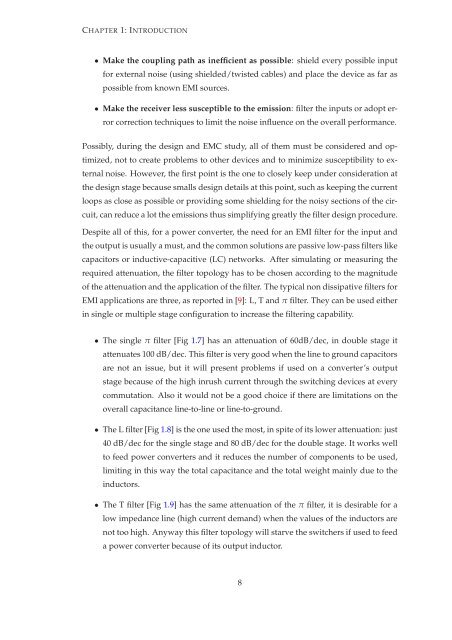PDF (Thesis) - Nottingham eTheses - University of Nottingham
PDF (Thesis) - Nottingham eTheses - University of Nottingham
PDF (Thesis) - Nottingham eTheses - University of Nottingham
You also want an ePaper? Increase the reach of your titles
YUMPU automatically turns print PDFs into web optimized ePapers that Google loves.
CHAPTER 1: INTRODUCTION<br />
• Make the coupling path as inefficient as possible: shield every possible input<br />
for external noise (using shielded/twisted cables) and place the device as far as<br />
possible from known EMI sources.<br />
• Make the receiver less susceptible to the emission: filter the inputs or adopt er-<br />
ror correction techniques to limit the noise influence on the overall performance.<br />
Possibly, during the design and EMC study, all <strong>of</strong> them must be considered and op-<br />
timized, not to create problems to other devices and to minimize susceptibility to ex-<br />
ternal noise. However, the first point is the one to closely keep under consideration at<br />
the design stage because smalls design details at this point, such as keeping the current<br />
loops as close as possible or providing some shielding for the noisy sections <strong>of</strong> the cir-<br />
cuit, can reduce a lot the emissions thus simplifying greatly the filter design procedure.<br />
Despite all <strong>of</strong> this, for a power converter, the need for an EMI filter for the input and<br />
the output is usually a must, and the common solutions are passive low-pass filters like<br />
capacitors or inductive-capacitive (LC) networks. After simulating or measuring the<br />
required attenuation, the filter topology has to be chosen according to the magnitude<br />
<strong>of</strong> the attenuation and the application <strong>of</strong> the filter. The typical non dissipative filters for<br />
EMI applications are three, as reported in [9]: L, T and π filter. They can be used either<br />
in single or multiple stage configuration to increase the filtering capability.<br />
• The single π filter [Fig 1.7] has an attenuation <strong>of</strong> 60dB/dec, in double stage it<br />
attenuates 100 dB/dec. This filter is very good when the line to ground capacitors<br />
are not an issue, but it will present problems if used on a converter’s output<br />
stage because <strong>of</strong> the high inrush current through the switching devices at every<br />
commutation. Also it would not be a good choice if there are limitations on the<br />
overall capacitance line-to-line or line-to-ground.<br />
• The L filter [Fig 1.8] is the one used the most, in spite <strong>of</strong> its lower attenuation: just<br />
40 dB/dec for the single stage and 80 dB/dec for the double stage. It works well<br />
to feed power converters and it reduces the number <strong>of</strong> components to be used,<br />
limiting in this way the total capacitance and the total weight mainly due to the<br />
inductors.<br />
• The T filter [Fig 1.9] has the same attenuation <strong>of</strong> the π filter, it is desirable for a<br />
low impedance line (high current demand) when the values <strong>of</strong> the inductors are<br />
not too high. Anyway this filter topology will starve the switchers if used to feed<br />
a power converter because <strong>of</strong> its output inductor.<br />
8
















